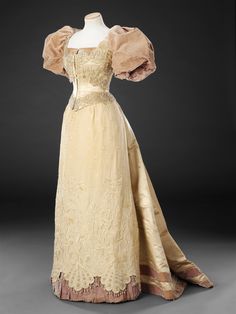Since Lara made me the Early Bustle polonaise, and since I'm building the undergarments (and the skirt) for it, it seems like it would be a shame to only have one gown that I can wear with it. (I know, right?) However, that skirt and bustle are still in process, and I'm not starting on a new project until I finish something, so I'm resolved to hold off on a second 1870s project. For now.
However, I can't not ruminate and plan, so here is the current thinking.
This all started because a friend gifted me with a silk queen duvet cover and shams of striped two-tone gray or silver dupioni. It seems to cry out as Early Bustle, especially since this striped pattern appears in Janet Arnold, taken from the gray and blue striped original.The original ensemble is silk and cotton, with blue ruchings and fringe trim. It's a 6-piece ensemble consisting of skirt and overskirt, basque, two bodices, and a gilet. One bodice is a day bodice, and the gilet is a detachable filler for the deep square neckline. The other bodice is an evening bodice.
This is an elegant solution to issues of economy in both the cost of fabric and space, and it meets my interest in the "capsule" wardrobe concept, in which several coordinating pieces can be combined in an assortment of ways to achieve a variety of looks and uses.
The basque is removable, and I can imagine a couple of basques created for this ensemble with different shapes and decoration to switch up the presentation.
An additional feature of the evening bodice is a net or beaded lace insert to draw the neckline in, adjusting it to the desired shoulder placement.
I'm also attracted to this original gown because of the liberal use of buttons - I'm kind of a button fiend, and my "trademark" is using non-matching buttons of a similar size and color on all my Neo-Victorian creations.
The other things that I especially love about this gown are the bias-cut ruffles, and the yards upon yards of bubble gathered ruchings. I'm not sure how I feel about the fringe; my personal taste runs to lace. We'll see about that.The ensemble would take a woman from day into evening with a simple change of the bodice. During the day, the ensemble would be worn with long sleeves and the removable gillet and be termed a "day" dress; in the evening, the lower sleeve and gillet would be removed for dinner or a social event; the entire bodice changed to the low neckline and short sleeves to convert the ensemble into a ball gown.
Several dressmakers [1] [2] have recreated the pattern, so I've been looking at their dress diaries to see how they addressed Arnold's pattern. I'll admit it; I don't have a ton of confidence drafting patterns from Arnold. They're complex. So much stuff. Parts and parts.
I feel more comfortable starting with a known quantity, so I'm going to buy Truly Victorian patterns and start with making adjustments from them. This should work well, since most dress pieces followed a set of standard forms; skirts were similar shapes, and bodices all are basically about the same. The patterns are as follows:










